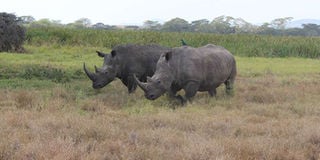KWS draws up new rules to guide rhino translocation

Black rhinos graze at Lewa Conservancy. The Kenya Wildlife Service was criticised for the death of black rhinos during translocation. PHOTO | FILE | NATION MEDIA GROUP
What you need to know:
- Fourteen rhinos were to be moved to Tsavo East National Park — eight from Nairobi National Park and six from Nakuru.
- Cabinet Secretary Balala said professional negligence led to the death of one of the rhinos after an attack by lions.
After earning flak following the deaths of 11 black rhinos during translocation to Tsavo East National Park in June, the Kenya Wildlife Service (KWS) has published new guidelines that will inform future translocations.
The guidelines released on Monday dictate that four committees, including the KWS board of trustees, will be involved in the activity.
"The immobilisation protocol for the white and black rhinos has been developed to guide translocation in view to increase need for veterinary interventions. It is intended to ensure the exercise is carried out using the best practices," acting Director-General Charles Musyoki said.
NEGLIGENCE
Investigations into the deaths show key rules were ignored by the management. For instance, former board chairman Richard Leakey told National Assembly's Environment and Natural Resources Committee that Tourism Cabinet Secretary Najib Balala, Wildlife Principal Secretary Margaret Mwakema and former KWS acting Director-General Julius Kimani forced the translocation of the rhinos despite resistance from board members owing to salinity levels of the water from the boreholes in Tsavo.
Fourteen rhinos were to be moved to the 100-kilometre-square conservancy — eight from Nairobi National Park and six from Nakuru.
APPROVAL
Mr Balala released a report that revealed the rhinos died due to multiple stress syndrome, which was intensified by salt poisoning, dehydration, starvation and gastric issues.
Mr Balala also admitted that professional negligence took place at the release site: One of the rhinos died following an attack by lions.
The guidelines delineate that decision-making process will be undertaken by four committees: Biodiversity Research and Planning, Species Introduction and Reintroduction, KWS Executive Committee and the Board of Trustees, who will make the final approval.
If there is no active board, the guidelines say, the final decision will be made by the Cabinet secretary.
Once the exercise is approved, a multidisciplinary coordination committee is expected to come in and oversee the translocation.
EXPERTS
The committee conducting the exercise will comprise scientists, security personnel, veterinarians as well as pilots. Also captured in the rules are the types of tranquilliser drugs to be administered to the animals.
Other requirements are: Veterinary doctors should monitor the health of the animals throughout the exercise, studies must be carried out on suitable habitats, filing of frequent progress reports and hiring of qualified personnel.
"[The drivers] shall be told to avoid sharp breaks and acceleration, and to drive slowly on rough roads. Two drivers shall be used for long journeys to ensure a rapid, uninterrupted trip and to avoid problems with driver fatigue," the guidelines say.




